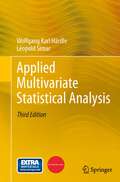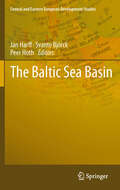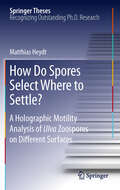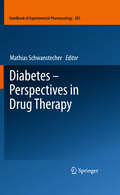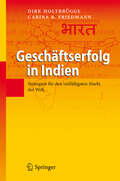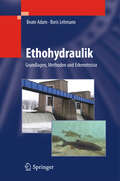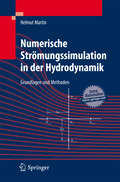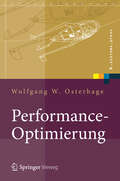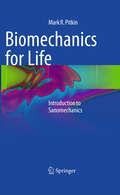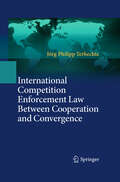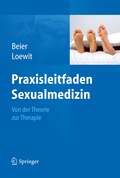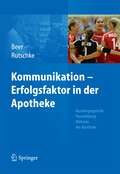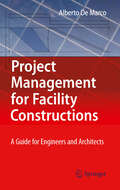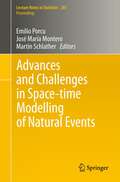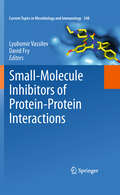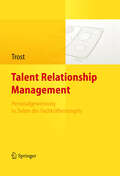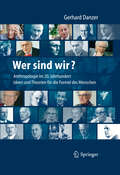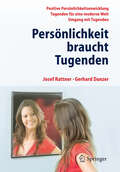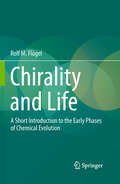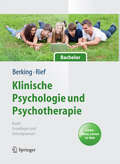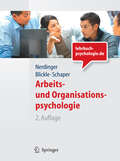- Table View
- List View
Applied Multivariate Statistical Analysis
by Wolfgang Karl Härdle Léopold SimarMost of the observable phenomena in the empirical sciences are of a multivariate nature. In financial studies, assets are observed simultaneously and their joint development is analysed to better understand general risk and to track indices. In medicine recorded observations of subjects in different locations are the basis of reliable diagnoses and medication. In quantitative marketing consumer preferences are collected in order to construct models of consumer behavior. The underlying data structure of these and many other quantitative studies of applied sciences is multivariate. Focusing on applications this book presents the tools and concepts of multivariate data analysis in a way that is understandable for non-mathematicians and practitioners who need to analyze statistical data. The book surveys the basic principles of multivariate statistical data analysis and emphasizes both exploratory and inferential statistics. All chapters have exercises that highlight applications in different fields.The third edition of this book on Applied Multivariate Statistical Analysis offers the following new featuresA new Chapter on Regression Models has been addedAll numerical examples have been redone, updated and made reproducible in MATLAB or R, see www.quantlet.org for a repository of quantlets.
Strategies and Communications for Innovations: An Integrative Management View for Companies and Networks
by Michael Hülsmann Nicole PfeffermannThe innovation economy sets new standards for global business and requires efficient innovation management to plan, execute and evaluate innovation activities, establish innovative capability and coordinate resources and capacities for innovation on an intra- and inter-organizational level. Moreover, communication of innovation is one essential impact factor of innovation success due to successful launches of innovations into markets, establishment of stakeholder relationships, and strengthened corporate reputation in the long-run. Consequently, the portfolio of communication activities for innovations has to be mastered by a company or collaborative network equal to the innovation portfolio. Thus, management of innovation and innovation communication on a strategic level play an important role in business nowadays. This new book concentrates on new approaches and methods for strategies and communications for innovations. As one part of the book, integrated perspectives on strategy and communication for innovation intend to bridge the gap between innovation management and communication management. This new book shall contribute to management science and answer current question in business. It provides cutting-edge information and offers a knowledge source for researchers, students, and business representatives who design, implement and manage innovation and innovation communication / marketing of innovation.
The Baltic Sea Basin
by Jan Harff Peer Hoth Svante BjörckThis book reports about the results of a Special Symposium "The Baltic Sea Basin", held on August 11, 2008, within the frame of the 33rd IGC at Oslo, Norway in order to foster the understanding of the Baltic Basin as a unit in terms of genesis, structure, ongoing processes and utilization. It is the first time that in a joint publication, scientists from different disciplines give a comprehensive overview about the Baltic Sea basin in such a general sense. The book will be used not only by students and scientist but also by engineers and decision makers from industry and politics. Summarizing the state of the art in the investigation of the Baltic Sea Basin, but also in the resource utilisation of the basin the book will enhance the development of new monitoring strategies and technical device design including satellite observation methods, the establishment of international research laboratories, innovative topics for interdisciplinary research projects, etc.
How Do Spores Select Where to Settle?
by Matthias HeydtIn this thesis, Matthias Heydt applies digital in-line holography to achieve for the first time a complete three dimensional and real time motion analysis of Ulva zoospores, both in solution and in the vicinity of different surfaces. These results provide previously unknown information about the behavior and mechanism spores use to select a suitable site for settlement. This work gives deeper insight into biofouling algae and stimulates new design strategies for antifouling coatings. Furthermore, the tracking system developed during this research could be used as a new system for assessing the antifouling performance on different surfaces at very early points in time, allowing disentanglement of surface conditioning and interaction of spores with pristine chemistries.
Diabetes - Perspectives in Drug Therapy
by Mathias SchwanstecherThe chapters of this book report cutting-edge research on molecular events in adiposity and type 2 diabetes, thus opening the way for innovative drug-based therapeutic strategies. It addresses all those who wish to keep in touch with recent developments in the field.
Geschäftserfolg in Indien
by Carina B. Friedmann Dirk HoltbrüggeTrotz der rasanten wirtschaftlichen Entwicklung Indiens sollten Unternehmen ein Engagement in dem Land sorgfältig prüfen. Basierend auf langjähriger Beratung und empirischen Studien liefern die Autoren eine Übersicht über die Merkmale des indischen Markts. Sie geben Entscheidungshilfen für Markteintritt und -bearbeitung und Ratschläge, wie Organisation und Personalmanagement sowie die Beziehung zu staatlichen und privaten Akteuren gestaltet werden können. Mit vielen Praxisbeispielen sowie einem umfangreichen Adressteil.
Ethohydraulik
by Beate Adam Boris LehmannUm Fließgewässer den Nutzungsansprüchen des Menschen anzupassen, sind unzählige Baumaßnahmen erforderlich. Um die Auswirkungen wasserbaulicher Aktivitäten auf die in Fließgewässern lebenden Tiere zu untersuchen, wurde die Ethohydraulik entwickelt. Sie beruht auf der Ethologie (Erforschung des Verhaltens von Tieren) und der Hydraulik (Lehre von den bewegten Flüssigkeiten). Die Autoren stellen die Grundlagen dieser Wissenschaftsdisziplin dar und liefern Regeln sowie Grenz- und Bemessungswerte für die wasserbauliche Praxis.
Numerische Strömungssimulation in der Hydrodynamik
by Helmut MartinDer Band liefert eine Einführung in die numerische Strömungssimulation im Bau- und Wasserwesen. Nach einem Überblick über die Methoden werden in Teil 1 Grundlagen und Grundgleichungen der Strömungsmechanik formuliert. In Teil 2 werden ausgewählte Methoden wie die Finite-Element-Methode, das Galerkin-Verfahren, die Finite-Volumen- und Finite-Element-Methode anhand von Beispielen aus der Hydrodynamik erläutert. Vier Programme, mit denen Beispiele im Buch bearbeitet werden können, stehen Lesern unter http://extras.springer.com zur Verfügung.
Performance-Optimierung
by Wolfgang W. OsterhageComputer-Hardware ist heute zwar erschwinglich, dennoch spielt Performance nach wie vor eine wichtige Rolle - auch wegen der Beanspruchung großer Ressourcen bei komplexen Anwendungen. In dem Band werden drei Ebenen unterschieden (Systeme, Anwendungen und Geschäftsprozesse), auf denen sich Optimierungen erzielen und Kostenpotenziale erschließen lassen. Entsprechende Theorien, Messmethoden sowie Lösungsvorschläge zur Umsetzung von Optimierungsmaßnahmen auf der jeweiligen Ebene werden erläutert. Mit Checklisten für Messungen und Optimierungsmaßnahmen.
Biomechanics for Life: Introduction to Sanomechanics
by Mark R. PitkinThe reader will find in this book a new approach to improving health. The author has called this approach "sanomechanics," combining the Latin sanus (healthy, sound) and mechanicus (science of the motion of bodies subjected to forces). The focus of sanomechanics is on exercising with an understanding of the biomechanical consequences of the actions. This understanding is based on the author's theory of the floating skeleton, which postulates a hydraulic connection of synovial joints. The theory explains the greater or lesser success of any exercise utilizing the ability of the human skeleton to absorb and transform forces and moments from the body segments and the environment. This ability vanishes with age and illnesses, and the deeper our understanding of the nature of skeletal functioning is, the better we shall be able to improve, protect, and prolong the skeleton's health.
Unternehmen Zahnarztpraxis - die Bausteine des Erfolgs
by Nicole Franzen Francesco TafuroNiedergelassene Zahnärzte müssen nicht nur medizinisches Geschick unter Beweis stellen, auch unternehmerische- und Führungs-Qualitäten sind gefragt. Die Autoren beschreiben den Weg zur erfolgreichen Praxis anhand von Themenblöcken: der Zahnarzt als Unternehmer-Persönlichkeit, Betriebswirtschaft, professioneller Praxisauftritt, Teamaufbau und -führung, Organisation und Zeitmanagement, Beratungs- und Aufklärungsgespräche. Fallbeispiele und Praxistipps erleichtern die Analyse der eigenen Situation. Checklisten, Formulare und Textvorlagen auf CD-ROM.
International Competition Enforcement Law Between Cooperation and Convergence
by Jörg Philipp TerhechteThe international dimensions of competition law and policy are most often examined at the level of substantive law. In this legal area both intentional and spontaneous assimilation and harmonization trends can be recognized, which manifest themselves e.g. in comparable approaches to combating particularly harmful restraints (so-called "hardcore cartels"). However, the complex terrain of enforcement law has been mainly ignored up to date. Are there common approaches in this field as well? How are the various competition laws linked with each other in respect to procedural norms? This book conceptualizes "International Competition Enforcement Law" against the backdrop of these issues and at the level of comparative law. The ciphers "cooperation" and "convergence" will serve as the two principle ideas for this book.
Praxisleitfaden Sexualmedizin
by Kurt K. Loewit Klaus M. BeierSexualität ist für das Leben des Einzelnen und auf vielfältige Weise für die Gesellschaft insgesamt von Bedeutung. Deshalb muss ihr in der Medizin und im Gesundheitswesen derselbe Stellenwert zukommen, wie das für andere elementare Lebensbereiche längst selbstverständlich ist. Aufbauend auf einer umfassenden Theorie als Grundlage einer ganzheitlichen Therapie liefern die Autoren einen therapieorientierten Praxisleitfaden, in dem die einzelnen Störungen präzise dargestellt sind.
Kommunikation - Erfolgsfaktor in der Apotheke
by Roland Rutschke Michaela BeerGelungene Kundenkommunikation ist die Grundlage des Erfolgs für Apotheken. In dem Band stellen die Autoren dar, welche Faktoren am Verkaufstresen dazu beitragen, dass Kommunikation gelingt, und welche sie scheitern lassen. Dabei werden die Leitlinien der Bundesvereinigung Deutscher Apothekerverbände genauso thematisiert wie Kommunikationssituationen mit schwierigen Kunden. Ferner behandeln die Autoren die Kommunikation im Team: Teambildung, Führung, Motivation und Konflikte. Mit Checklisten für eine erfolgreiche Umsetzung.
Project Management for Facility Constructions: A Guide for Engineers and Architects
by Alberto De MarcoThis book describes concepts, methods and practical techniques for managing projects to develop constructed facilities in the fields of oil & gas, power, infrastructure, architecture and the commercial building industries. It is addressed to a broad range of professionals willing to improve their management skills and designed to help newcomers to the engineering and construction industry understand how to apply project management to field practice. Also, it makes project management disciplines accessible to experts in technical areas of engineering and construction. In education, this text is suitable for undergraduate and graduate classes in architecture, engineering and construction management, as well as for specialist and professional courses in project management.
Advances and Challenges in Space-time Modelling of Natural Events (Lecture Notes in Statistics #207)
by José–maría Montero Emilio Porcu Martin SchlatherThis book arises as the natural continuation of the International Spring School "Advances and Challenges in Space-Time modelling of Natural Events," which took place in Toledo (Spain) in March 2010. This Spring School above all focused on young researchers (Master students, PhD students and post-doctoral researchers) in academics, extra-university research and the industry who are interested in learning about recent developments, new methods and applications in spatial statistics and related areas, and in exchanging ideas and findings with colleagues.
Small-Molecule Inhibitors of Protein-Protein Interactions
by David Fry Lyubomir VassilevIn this volume, the editors have collected the knowledgeable insights of a number of leaders in this field - researchers who have achieved success in addressing the difficult problem of inhibiting protein-protein interactions. These researchers describe their unique approaches, and share experiences, results, thoughts, and opinions. The content of the articles is rich, and in terms of scope ranges from generalized approaches to specific case studies. There are various focal points, including methodologies and the molecules themselves. Ultimately, there are numerous lessons to be taken away from this collection, and the editors hope that this snapshot of the current state of the art in developing protein-protein inhibitors not only pays tribute to the past successes, but also generates excitement about the future potential of this field
Talent Relationship Management
by Armin TrostAngesichts des dramatisch zunehmenden Fachkräftemangels wird es für Unternehmen in Zukunft noch schwieriger sein, Schlüsselfunktionen zu besetzen. Neue, aktive und teils aggressive Methoden werden gebraucht, um die wenigen talentierten Kandidaten zu finden und an das Unternehmen zu binden. Der Autor - Berater und Professor an einer innovativen Business-School - stellt das Konzept Talent Relationship Management (TRM) anhand von Fallbeispielen vor und gibt Tipps, wie TRM in Unternehmen (auch in kleinen und mittelständischen) umgesetzt werden kann.
Talent Relationship Management: Personalgewinnung in Zeiten des Fachkräftemangels
by Armin TrostAngesichts des dramatisch zunehmenden Fachkräftemangels wird es für Unternehmen in Zukunft noch schwieriger sein, Schlüsselfunktionen zu besetzen. Neue, aktive und teils aggressive Methoden werden gebraucht, um die wenigen talentierten Kandidaten zu finden und an das Unternehmen zu binden. Der Autor – Berater und Professor an einer innovativen Business-School – stellt das Konzept Talent Relationship Management (TRM) anhand von Fallbeispielen vor und gibt Tipps, wie TRM in Unternehmen (auch in kleinen und mittelständischen) umgesetzt werden kann.
Wer sind wir? Auf der Suche nach der Formel des Menschen
by Gerhard DanzerAnthropologie ist der Versuch des Menschen, nach seinem Wesen und seiner Natur zu fragen sowie seine Herkunft und Möglichkeiten zu ergründen. Während sich Philosophen schon immer mit diesem Thema beschäftigt haben, sind im 20. Jahrhundert viele Disziplinen hinzugekommen. Der Autor beschreibt anhand von 35 biografischen und werkanalytischen Erörterungen, wie sich Ärzte und Philosophen im 20. Jahrhundert auf die Suche nach der "Formel des Menschen" begeben haben. Dabei setzt er sich mit den verschiedenen Denkrichtungen kritisch auseinander.
Persönlichkeit braucht Tugenden
by Gerhard Danzer Josef RattnerSpielen im 21. Jahrhundert Tugenden eigentlich noch eine Rolle? Der Autor beschreibt in seinem Buch neun Charakterzüge und Wesensmerkmale, die für die Entwicklung eines Menschen seiner Meinung nach von Bedeutung sind. Dazu gehören beispielsweise Besonnenheit, Hingabe, Humor, aber auch Vornehmheit. Ein Buch, mit dem der Autor auf unterhaltsame Art und Weise zum Nachdenken über die eigenen Tugenden anregt.
Psychische Störungen bei Mitarbeitern
by Ina RiechertPsychische Störungen wie Ängste, Depressionen oder Abhängigkeiten sind heute einer der häufigsten Gründe für Fehltage und Berufsunfähigkeiten von Arbeitnehmern. Im Vergleich zu anderen Erkrankungen führen sie zu besonders langen Fehlzeiten. Umso dramatischer: Diese Erkrankungen werden viel zu spät entdeckt, werden chronisch und die Folgen für die Unternehmen extrem teuer. Dabei gibt es Anzeichen, die Führungskräfte, Kollegen und Personaler erkennen können, und Möglichkeiten, gestaltend einzugreifen und damit Kosten zu senken. Einen Betrag dazu leistet dieses Buch: Es liefert verständliches Grundwissen zu psychischen Störungen für Führungskräfte und Personalverantwortliche, hilft bei der Früherkennung von Fehlbelastungen und gibt handfeste Tipps zum Umgang mit gefährdeten Mitarbeitern, zur Prävention im Unternehmen und zur Wiedereingliederung. Gedanken-Experimente und Reflexionsfragen helfen, den Blick zu schärfen; ausführliche Checklisten (auch zum Download) unterstützen bei der Durchführung und Implementierung der Maßnahmen. Neu in der 2. Auflage: Das Trendthema betriebliche Gefährdungsanalyse. Es lohnt sich, das Thema ,,Psychische Gesundheit der Mitarbeiter" für sich zu ,,erobern", denn es können nicht nur die Betroffenen dabei gewinnen: Der Betrieb entwickelt leistungsfähige und engagierte Mitarbeiter mit geringen Fehlzeiten, die Träger der Sozialversicherung werden entlastet, die Beiträge bleiben stabil und die Lohnnebenkosten geringer.
Chirality and Life: A Short Introduction to the Early Phases of Chemical Evolution
by Rolf M. FlügelThis book presents the fascinating formation of the first simple bioorganic molecules and describes the hidden aspects of chiral compounds, which raise questions on the molecular beginnings of life. The occurrences of extraterrestrial, non-standard amino acids in meteorites are dealt with in detail, as well as their subsequent transfer to proteinogenic amino acids. The concept of asymmetric organo-catalysis for the synthesis of carbohydrates and ribonucleosides are considered. The notion of a single amino acid that functions as an enzyme is developed. Attempts to simulate ancient world scenarios are critically reviewed. There is a special focus on ribozymes and the resulting RNA world. Combinations of different world scenarios are discussed in view of an on-going evolution. The currently most plausible hypotheses and visions of ancient world scenarios that led to today's DNA world are also provided. Included is a pre-cellular world of viruses that is presented for the first time.
Klinische Psychologie und Psychotherapie für Bachelor
by Matthias Berking Winfried RiefDieser Band des zweibändigen Werks behandelt alle prüfungsrelevanten Themen zu Therapieverfahren - von klassischen Verfahren bis hin zu modernen Ansätzen wie CBASP sowie die Wirkfaktoren von Psychotherapie. Eine Randspalte enthält die wichtigsten Informationen. Fallbeispiele, Praxistipps, Definitionen, interessante Studien, Lernziele und Kontrollfragen ermöglichen abwechslungsreiches Lernen. Die begleitende Website bietet Lernmaterialien und Videos für Studierende, Foliensätze für Dozenten - und alle Kapitel als Hörbeiträge zum kostenlosen Download.
Arbeits- und Organisationspsychologie (Springer-Lehrbuch)
by Gerhard Blickle Niclas Schaper Friedemann NerdingerDas Lehrbuch zum beliebtesten Anwendungsgebiet der Psychologie deckt die Bereiche Organisation, Personal und Arbeit in ihren Grundlagen und ihrer Praxis ab: Wovon hängt es ab, ob jemand zufrieden mit der Arbeit ist? Welche Prozesse finden bei Fusionen und Unternehmensübernahmen statt? Wie funktioniert Personalentwicklung? Was ist organisationale Sozialisation? Drei ausgewiesene Experten beantworten diese Fragen fundiert und anschaulich. Mit Glossar der wichtigsten Fachbegriffe und begleitender Website mit Materialien für Studierende und Dozenten.
